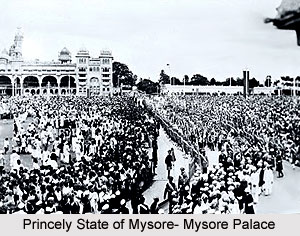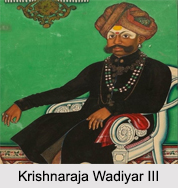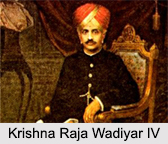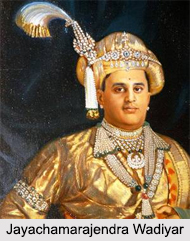Introduction
 The Princely State of Mysore was formed by the British East India Company in the year 1799 after the victory of the British in the Fourth Anglo Mysore War. It remained under the indirect rule of the Company during the British dominion in India. The princely state existed until the year 1947, as after the country achieved independence, Mysore state was acceded to the newly formed Union of India. The princely state of Mysore was created out of the Kingdom of Mysore, which was much larger than the princely state. The Kingdom of Mysore was ruled by the well known Muslim Sultans, Haidar Ali and Tipu Sultan between the years 1761 and 1799. The Princely State of Mysore was among the 3 largest princely states during the British rule in India.
The Princely State of Mysore was formed by the British East India Company in the year 1799 after the victory of the British in the Fourth Anglo Mysore War. It remained under the indirect rule of the Company during the British dominion in India. The princely state existed until the year 1947, as after the country achieved independence, Mysore state was acceded to the newly formed Union of India. The princely state of Mysore was created out of the Kingdom of Mysore, which was much larger than the princely state. The Kingdom of Mysore was ruled by the well known Muslim Sultans, Haidar Ali and Tipu Sultan between the years 1761 and 1799. The Princely State of Mysore was among the 3 largest princely states during the British rule in India.
History of Princely State of Mysore
The British East India Company annexed the southern and coastal regions of the Kingdom of Mysore to the Madras Presidency under British India. Moreover the British administration turned over the north eastern regions to the state of Hyderabad. The interior region of the Kingdom was converted into a princely state which was state under the suzerainty of the British Crown. The Hindu Wodeyar dynasty was reinstated as the rulers of the princely state of Mysore. They merely acted as puppet monarchs, who had local authority but the economic and political control of the state remained under the control of the British Government of India. The rulers were titled and styles as Maharajas of Mysore. Thus Krishna Raja Wodeyar III, also known as Mummadi Krishnaraja Wodeyar, ascended the throne of the princely state of Mysore.
The last Maharaja of the princely state of Mysore, Jayachamaraja Wodeyar Bahadur, reigned over the territory from 1940 to 1950. His rule ended after he signed the instrument of accession after India gained independence in the year 1947. The last ruler of Mysore merged his state with the Union of India by signing the instrument of accession on 9th August 1947. The regions of the former princely state of Mysore were restructured into a state within the newly formed Union of India.
Rulers of Princely State of Mysore
The chronology of the Maharajas of the Princely State of Mysore is discussed as follows-
* Mummadi Krishna Raja Wodeyar III (1799- 1868)
* Chamaraja Wodeyar X (1868- 1894)
* Vani Vilasa Sannidhana- Regent (1894- 1902)
* Nalvadi Krishna Raja Wadiyar IV (1902- 1940)
* Jayachamaraja Wodeyar (1940- 1947)
Princes of Mysore
 During British rule in India, the princely state of Mysore was ruled by different princes. They served the state as Maharajas of the kingdom of Mysore. These princes are given below.
During British rule in India, the princely state of Mysore was ruled by different princes. They served the state as Maharajas of the kingdom of Mysore. These princes are given below.
Krishnaraja Wadiyar III
Krishnaraja Wadiyar III ruled the state of Mysore from 30th of June, 1799 to 19th of October, 1831. He is recognized to have brought about cultural growth in the state. This can be comprehended from the fact that Krishnaraja Wadiyar III was a great Kannada and Sanskrit Scholar, a writer, knew different languages and was skilled in playing the musical instrument, called veena. Krishnaraja had patronized many scholars in his court. He had revived the Ganjifa game. He is credited with the growth and survival of the Yakshagana form of Literature.
Chamarajendra Wadiyar X
Chamarajendra Wadiyar X served as the 23rd Maharaja of Mysore between 1868 and 1894. He is known to have patronized art and music. Chamarajendra is credited with the institution of the Representative Assembly of Mysore state in 1881, which was the first modern, democratic legislative institution of its kind in princely India. Giving importance to women`s education, Chamarajendra had established the Kannada Bashojjivini School. He had instituted several industrial schools as well. He helped in the establishment of agricultural banks as a source of financial aid to farmers.
Krishna Raja Wadiyar IV
Krishna Raja Wadiyar IV acted as the Maharaja of the princely state of Mysore from 1894 until his death in 1940. According to Paul Brunton, this philosopher-king used to follow the ideal expressed in Plato`s Republic. He is regarded as a appreciator of Carnatic and Hindustani music. During the rule of Krishna Raja, various kinds of development had taken place in Mysore. Some of the establishments that took place were University of Mysore, Yuvaraja College, State Bank of Mysore, Mysore Boy Scouts, Mysore Legislative Council, Mysore Medical College and Krishna Rajendra Hospital. At that time, Bangalore became the first city in India to get electric street lights.
Jayachamarajendra Wadiyar
Jayachamarajendra Wadiyar is documented in the pages of history as the last and the 25th Maharaja of the princely state of Mysore. He had ruled the state from 1940 to 1950. He is also remembered as a philosopher, musicologist, political thinker, philanthropist and the founder-president of Vishva Hindu Parishad (World Hindu Council). He is known to be a good horseman and a tennis player who helped Ramanathan Krishnan to participate in Wimbledon. He was an appreciator of both Western and Carnatic music. He had sponsored the translation of many classics from Sanskrit to Kannada.



















